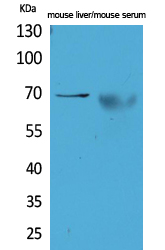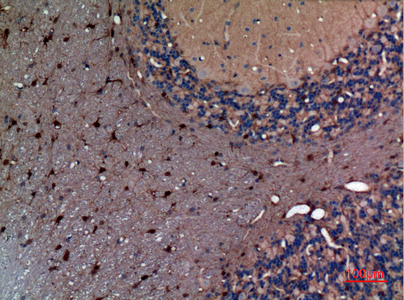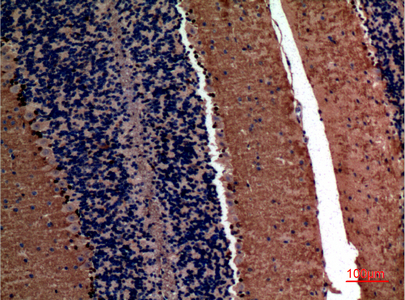AFP Polyclonal Antibody
- Catalog No.:YT5140
- Applications:WB;IHC;IF;ELISA
- Reactivity:Human;Rat;Mouse;
- Target:
- AFP
- Fields:
- >>Hippo signaling pathway
- Gene Name:
- AFP
- Protein Name:
- Alpha-fetoprotein
- Human Gene Id:
- 174
- Human Swiss Prot No:
- P02771
- Mouse Swiss Prot No:
- P02772
- Immunogen:
- The antiserum was produced against synthesized peptide derived from the Internal region of human AFP. AA range:371-420
- Specificity:
- AFP Polyclonal Antibody detects endogenous levels of AFP protein.
- Formulation:
- Liquid in PBS containing 50% glycerol, 0.5% BSA and 0.02% sodium azide.
- Source:
- Polyclonal, Rabbit,IgG
- Dilution:
- WB 1:500 - 1:2000. IHC: 1:100-300 ELISA: 1:20000.. IF 1:50-200
- Purification:
- The antibody was affinity-purified from rabbit antiserum by affinity-chromatography using epitope-specific immunogen.
- Concentration:
- 1 mg/ml
- Storage Stability:
- -15°C to -25°C/1 year(Do not lower than -25°C)
- Other Name:
- AFP;HPAFP;Alpha-fetoprotein;Alpha-1-fetoprotein;Alpha-fetoglobulin
- Observed Band(KD):
- 70kD
- Background:
- This gene encodes alpha-fetoprotein, a major plasma protein produced by the yolk sac and the liver during fetal life. Alpha-fetoprotein expression in adults is often associated with hepatoma or teratoma. However, hereditary persistance of alpha-fetoprotein may also be found in individuals with no obvious pathology. The protein is thought to be the fetal counterpart of serum albumin, and the alpha-fetoprotein and albumin genes are present in tandem in the same transcriptional orientation on chromosome 4. Alpha-fetoprotein is found in monomeric as well as dimeric and trimeric forms, and binds copper, nickel, fatty acids and bilirubin. The level of alpha-fetoprotein in amniotic fluid is used to measure renal loss of protein to screen for spina bifida and anencephaly. [provided by RefSeq, Jul 2008],
- Function:
- developmental stage:Occurs in the plasma of fetuses more than 4 weeks old, reaches the highest levels during the 12th-16th week of gestation, and drops to trace amounts after birth. The serum level in adults is usually less than 40 ng/ml. AFP occurs also at high levels in the plasma and ascitic fluid of adults with hepatoma.,function:Binds copper, nickel, and fatty acids as well as, and bilirubin less well than, serum albumin. Only a small percentage (less than 2%) of the human AFP shows estrogen-binding properties.,online information:Alpha-fetoprotein entry,PTM:Independent studies suggest heterogeneity of the N-terminal sequence of the mature protein and of the cleavage site of the signal sequence.,PTM:Sulfated.,similarity:Belongs to the ALB/AFP/VDB family.,similarity:Contains 3 albumin domains.,subunit:Dimeric and trimeric forms have been found in addition to the monomeric form.,tissue
- Subcellular Location:
- Secreted.
- Expression:
- Plasma. Synthesized by the fetal liver and yolk sac.
- June 19-2018
- WESTERN IMMUNOBLOTTING PROTOCOL
- June 19-2018
- IMMUNOHISTOCHEMISTRY-PARAFFIN PROTOCOL
- June 19-2018
- IMMUNOFLUORESCENCE PROTOCOL
- September 08-2020
- FLOW-CYTOMEYRT-PROTOCOL
- May 20-2022
- Cell-Based ELISA│解您多样本WB检测之困扰
- July 13-2018
- CELL-BASED-ELISA-PROTOCOL-FOR-ACETYL-PROTEIN
- July 13-2018
- CELL-BASED-ELISA-PROTOCOL-FOR-PHOSPHO-PROTEIN
- July 13-2018
- Antibody-FAQs
- Products Images

- Western Blot analysis of mouse liver, mouse serum cells using AFP Polyclonal Antibody. Secondary antibody(catalog#:RS0002) was diluted at 1:20000

- Immunohistochemical analysis of paraffin-embedded rat-brain, antibody was diluted at 1:100

- Immunohistochemical analysis of paraffin-embedded mouse-brain, antibody was diluted at 1:100

- Western blot analysis of lysate from mouse liver cells, using AFP Antibody.



